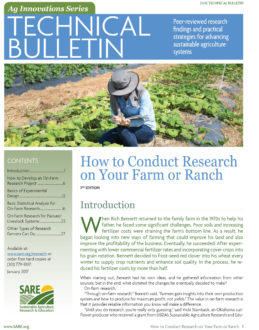By Kate Cesario
Conducting on-farm research allows producers to gain valuable knowledge on how to improve their farm or ranch. By learning the science behind the inner workings of a crop or livestock system, farmers can make changes to increase profitability or sustainability. Research projects are formed around farmers’ goals but are commonly aided by consultants and other research professionals. Even with outside help, on-farm research requires careful planning and familiarity with research methods and statistics. Learn how to perform effective and impactful research with SARE’s “How to Conduct Research on Your Farm or Ranch” bulletin.
Developing a Research Project
SARE’s 10-step process allows farmers to address production questions or problems scientifically. This framework outlines every consideration a farmer should make for establishing a research question, performing research effectively, and interpreting results. Profiles of producers who conducted successful research using SARE grants are included as examples of how this process can be applied on different types of farms and ranches.
Basics of Experimental Design
Step 4 of the 10-step guide is “Develop an experimental design.” This serves as the foundation of a research experiment as it plans out exactly how a farm system is altered to make a discovery. Planning must be thorough, so developing an experimental design requires patience. SARE provides more detail on what experimental design is and how it can be utilized in research on a farm or ranch. The bulletin explores common design methods and defines research jargon, ensuring that any farmer can conduct research no matter their expertise level with research methods.
Statistical Analysis for On-Farm Research
To draw conclusions about data, it must be analyzed using statistical parameters and tests. The amount and type of on-farm data collected determines which tests should be used. In the bulletin, farmers can learn two statistical tests that determine if there is a difference between control and treatment groups, since these types of experiments are typically run by farmers.
Research on Livestock and Other Areas
While this guide places a focus on crop-related research, farmers can also use research methods to learn about livestock systems or market trends. Tips for investigating different components of a farm system can be found in this section, along with profiles on producers who centered their research study around different vegetable varieties and meat market demands.
Learning how to run an on-farm research project requires a lot of knowledge on complex topics, but it can be helpful to understand a farm system on a deeper level using research findings. Regardless of how much experience a producer has with developing an experimental design or running statistical tests, this guide is an excellent resource to learn more about how a farm can be aided by the undertaking of research project.
